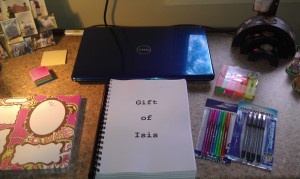Now that I’ve finished the first draft of MUSE, this manuscript will go into hibernation for a while. So I’ve spent the last few weeks wondering what I should move on to. It’s a battle between a call of the heart or market sensibility.
I can go back to a previous manuscript, a story I dearly love and which has garnered some attention from agents, but not enough for a contract. Clearly, there are problems with it that I’ve not yet identified. I can spend the next six months in a familiar world, with characters I know well and adore, and try to fix the problems with this manuscript. I’ve invested many years in this story — there’s even a first draft for the sequel — and I’m not ready to give up on it yet.
Another possibility is an urban fantasy I started early last year. I came close to the end of that draft and lost both momentum and interest in the story. Yet the idea had been rattling around in my head for several years before I was finally in the right place to write it. I’m sure I will eventually regain my passion for this story but it’s not calling to me just now.
I could start something new. I’ve been playing around with a number of ideas. One has a post-apocalyptic setting, something I’ve always wanted to try. Think Dan Brown but with more grit. Another is an urban fantasy in which the faerie world still exists side-by-side with the modern world. Human sacrifices, immortality, Pandora’s box. There are so many things I want to write about. The post-apocalyptic story is the one I suspect would be the most sensible to write. It’s controversial and, I think, eminently saleable. It would, if done right, be a gripping read. But it’s not calling to me either. At least, not yet.
I started writing this post about eight weeks ago, at a time when finishing the first draft of MUSE seemed very far off indeed, and over the last few weeks, no matter which idea I try out, it’s that first one, the story I’ve already spent ten years on, that draws me to it. In fact, it seems my subconscious has decided for me because last weekend, without ever making a conscious decision to return to this project, I went to the copy shop and had the manuscript printed and bound, all 585 pages. It’s sitting on the desk in my study now, along with new packs of pens and highlighters. And it’s calling me. For better or worse, this is what I’ll be spending the next few months on. Only time will tell whether it’s a wise use of my time or just another round of edits on a project that will never sell.
How do you decide between projects? Do you analyse the market and write what you think has the best chance of selling? Or do you let your heart make the decision?

